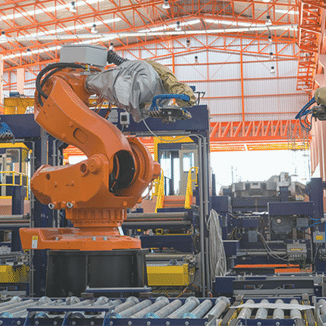A recent infographic published by Ohio University encapsulates how software and big data are transforming the manufacturing sector in the United States.
Manufacturing by the Numbers
- Manufacturing currently represents 12 percent of the American gross domestic product (GDP).
- Exports of U.S. manufactured goods totaled $1.3 trillion in 2013.
- The U.S. manufacturing sector has been in the midst of a renaissance in recent years, having increased its output by 30 percent since the end of the recession.
- 54% of American manufacturers are now considering bringing manufacturing back from China to the U.S.
- 80% of the world’s software is produced in the U.S., which also leads in big data analytics and intelligent sensors.
MES Software, Big Data and Manufacturing
As manufacturing moves towards Industry 4.0, software and big data are the main drivers in the sector’s transformation. Big data refers to datasets whose size is beyond the ability of typical database software tools to capture, store, manage, and analyze effectively. By introducing software-based big data analytics and more flexible production techniques, manufacturers can boost productivity by up to 30 percent. Moreover, big data can enable a 50 percent decrease in product development and assembly costs, as well as significant reduction in capital costs. This potential is just beginning to be tapped, as only 17 percent of manufacturers have reported implementing big data analytics solutions.
Big Data as a Revenue Driver
Data collected from sensors embedded in products is changing operations and transforming business models as service is moving from a cost factor to a revenue driver. This is happening through the leveraging of this data for after-sales offerings like OEM-managed proactive maintenance. A key area of transformation is product development, where simulations are used for performance analysis before physical prototypes are created. This advancement is characteristic of the “smart factory.”
Within modular-structured smart factories, cyber-physical systems monitor physical processes, create a virtual copy of the physical world, and make decentralized decisions. Over the Internet of Things, cyber-physical systems communicate and cooperate with each other and with humans in real time and via the Internet of Services. They are internal and cross-organizational services offered and used by participants of the value chain.
Big data is also supporting lean manufacturing, a business model that includes tactical operational techniques that eliminate non-value-added activities while delivering quality products on time with the lowest cost and much greater efficiency. One example of lean is leveraging big data analytics to gain insight into sales trends as a means of optimizing manufacturing efficiency.
Supply Chain Impacts of Software and Big Data
The use of big data analytics is also changing key elements of supply chain operations, including:
- Delivery routes: By using big data and advanced analytical techniques, manufacturers can save up to 20 percent on transportation costs.
- Demand forecasting: Companies can leverage big data to cut 20-30 percent of inventory while increasing average fill rates by three to seven percentage points.
- Distribution networks: By using big data analytics to optimize distribution networks, manufacturers can save up to 20 percent on freight and warehousing costs in addition to realizing significant inventory savings.
Big Data Challenges in Complex Manufacturing
While offering clear benefits to manufacturers, big data poses a number of challenges to managers:
- Identifying which data is relevant
- Understanding what data to use and what to discard
- Formulating the right questions to ask
A recent study of 179 large companies found that adopting data-driven decision-making processes achieved productivity gains that were five to six percent higher than other factors could explain. Bottom line: research suggests that companies that use data and business analytics are more productive and have higher returns on equity than competitors that don’t.







